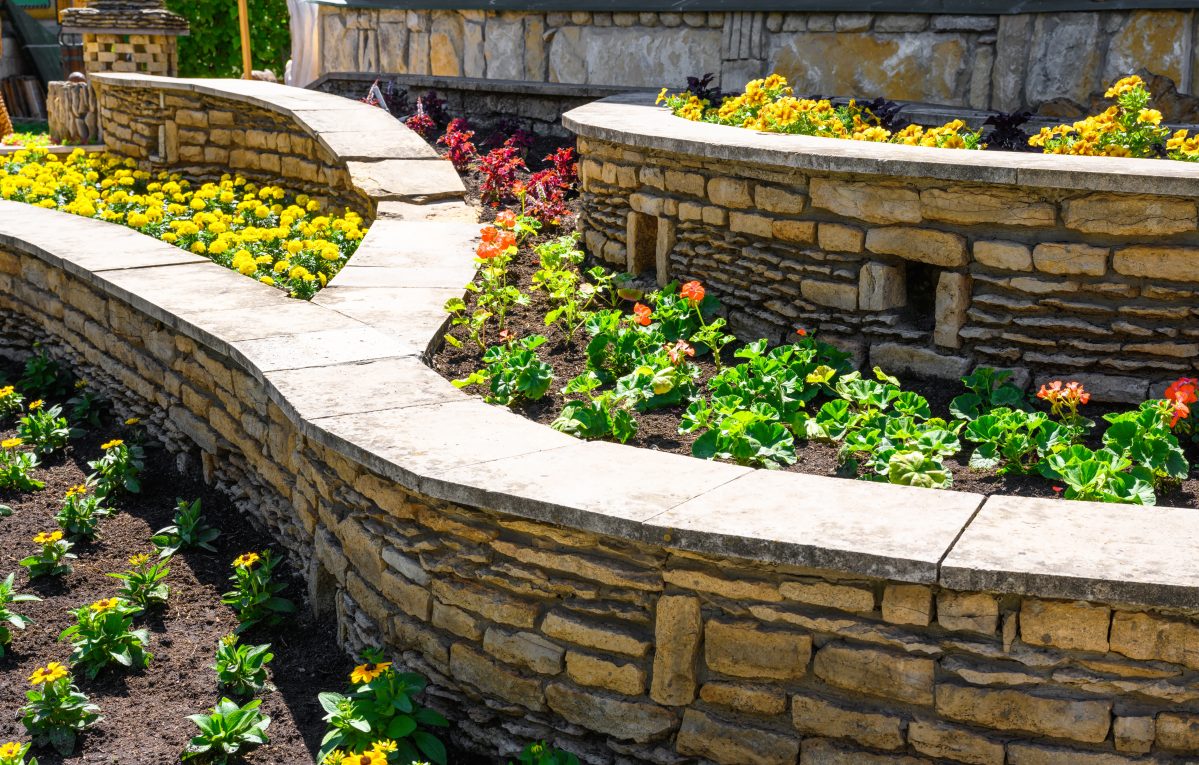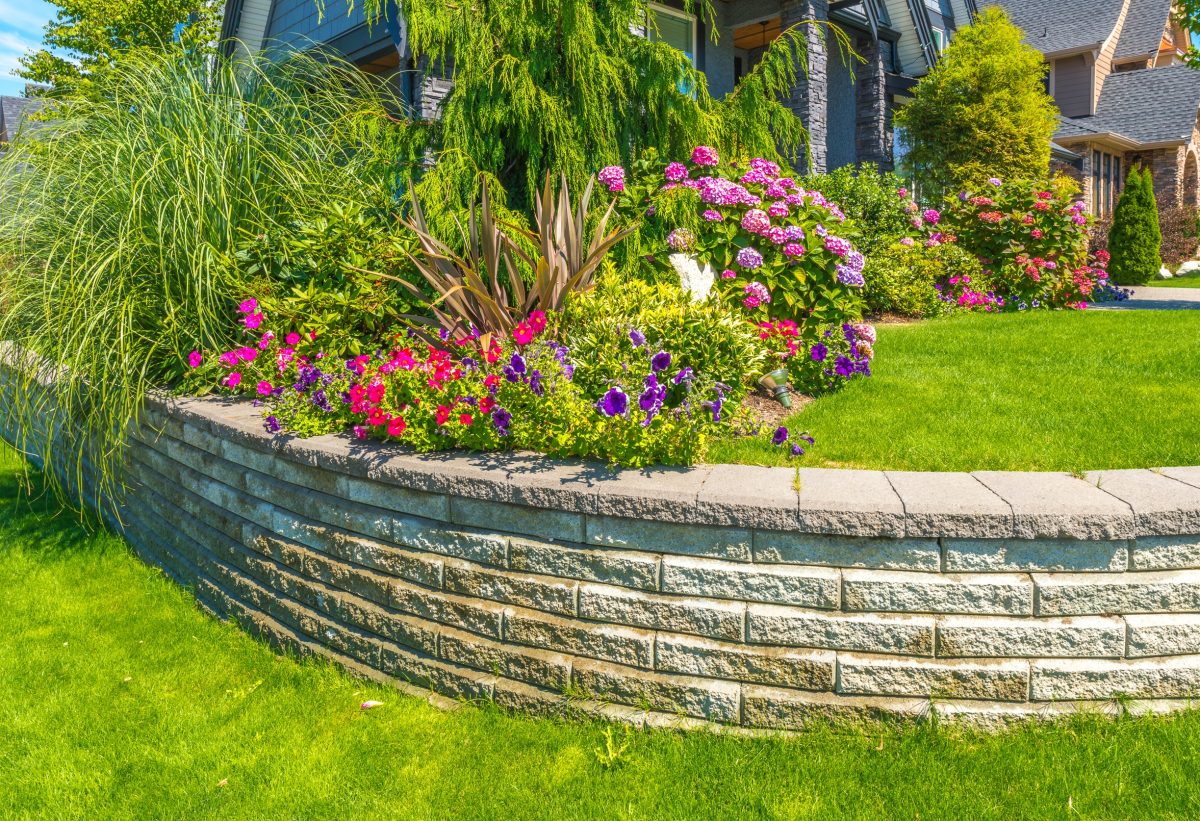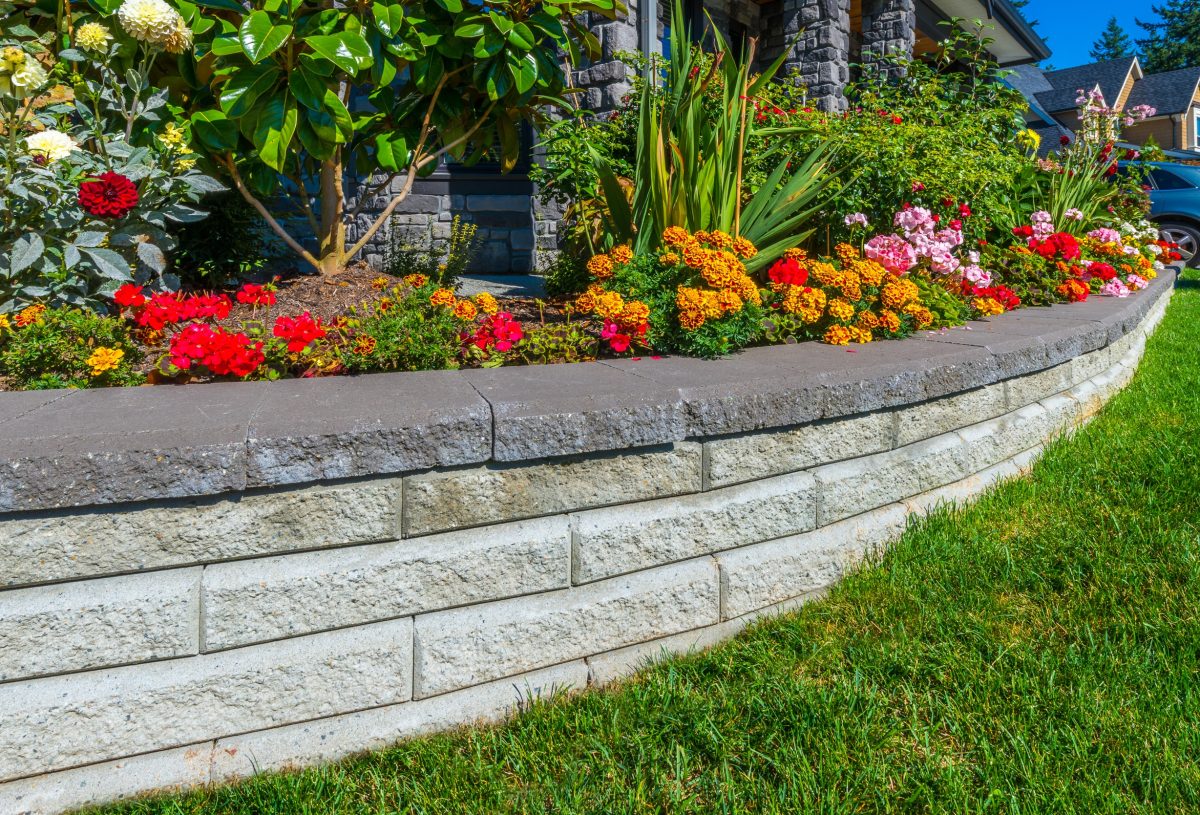
When you’re faced with the challenge of a sloping garden, retaining walls can be your saving grace. Not only do they provide practical support for soil erosion control, but they also offer an opportunity to enhance your outdoor space aesthetically. With the right choice of plants, retaining walls can transform into beautiful vertical gardens that add character and charm to your property.
Now, choosing the right plant for a retaining wall isn’t as simple as picking out something pretty from a nursery. You’ll need plants that are robust enough to thrive in challenging conditions – like shallow soil and varying moisture levels – while also being visually appealing throughout the year.
From creeping ground covers like sedum or thyme that cascade beautifully over edges, to hardy shrubs such as juniper or cotoneaster which provide year-round interest; there’s an extensive range of plants suitable for enhancing retaining walls. In this article, we’ll explore some excellent choices and give you tips on how best to establish them in these unique environments.
Understanding Retaining Walls and Their Function
So, you’re thinking about sprucing up your garden with some retaining walls? That’s a great idea! But before we dive into the nitty-gritty of plant ideas for these structures, it’s crucial to understand what they are and why they’re essential.
Firstly, let’s tackle what retaining walls are. In simple terms, they’re robust structures that hold back soil which would otherwise erode or slide away. They’re often found in landscapes where additional support is needed to prevent the earth from moving downhill with erosion.
Now you might be wondering: “Why do I need a retaining wall?” Well, besides providing functional benefits like preventing soil erosion and managing water runoff, these hardworking structures can also add aesthetic value to your outdoor space.
Imagine transforming an ordinary sloping yard into a beautiful landscape full of life by incorporating plants on your retaining wall – sounds exciting right? Besides adding beauty to your garden or backyard area – whether through vibrant flowers in spring or lush greenery all year round – having plants on your retaining wall can also create habitats for local wildlife.
However don’t just rush out there and start building; planning is key here! You’ll need proper drainage systems behind the wall as this helps keep pressure off it. Plus choosing suitable materials for construction will ensure longevity of both structure and aesthetics.
Choosing the Right Plants for Retaining Walls
The right plants can transform your retaining wall from a functional structure into a beautiful, living feature of your landscape. The trick is to pick plants that not only look good but are also suited to the unique conditions created by retaining walls.
Let’s start with ground cover plants. They’re an excellent choice for covering large areas and softening the hard lines of stone or concrete walls. Creeping phlox (Phlox subulata) and creeping thyme (Thymus serpyllum) are popular options here due to their low-growing habit and colourful flowers.
For an added burst of colour, consider flowering perennials such as Geraniums or Echinacea. These robust growers provide gorgeous blooms throughout summer months while being resilient enough to handle wall conditions.
If you’re after more architectural interest, ornamental grasses could be just what you need! Feather reed grass (Calamagrostis x acutiflora) creates a striking vertical accent while blue fescue (Festuca glauca) offers eye-catching silver-blue foliage.
Here’s something important: You must keep in mind that retaining walls can create challenging growing conditions – there may be less soil depth than usual, and drainage might differ too. Therefore it’s crucial when choosing plants that they are well-suited to these specific circumstances; drought-tolerant species like Sedum or Yucca often do particularly well in these settings.
Finally, don’t forget about climbers! If your wall is sturdy enough – ivy varieties like English Ivy or Boston Ivy – could add another layer of visual interest without adding much weight onto the structure itself.
Remember: Your plant selection should reflect not only personal aesthetic preferences but also practical considerations regarding growth habits and environmental suitability.

Top Plant Ideas for Enhancing Your Retaining Wall
Are you eager to add a dash of nature to your garden retaining wall? It’s simpler than you might think. Here, we’ll share some top plant ideas that can instantly spruce up your retaining wall and turn it into an appealing green space.
The first thing on our list is creeping plants. These are perfect if you’re looking for a quick cover-up solution. Creeping Phlox (Phlox stolonifera) and Ivy (Hedera helix) are two prime examples of these types of plants. They spread fast, cling onto the walls easily, and require minimal maintenance – making them ideal for busy homeowners.
Next up, let’s talk about succulents! Their unique shapes and vibrant colours make them excellent candidates for beautifying your retaining walls while being quite low-maintenance as well. Hen-and-chicks (Sempervivum tectorum) or Stonecrop (Sedum spp.) could be great choices here.
Fancy something with flowers? Why not try adding some flowering perennials such as Daylilies (Hemerocallis), Bellflowers(Campanula portenschlagiana), or Coral Bells(Heuchera)? They’ll provide wonderful bursts of colour throughout different seasons while offering a welcoming habitat for pollinators like bees and butterflies.
If height is what you’re after then consider planting shrubs along the base of your wall like Hydrangeas(Hydrangea macrophylla). Their large flower clusters will create dramatic visual interest whilst their root systems help stabilise soil behind the retaining structure.
Finally, don’t forget about herbs! Not only do they offer culinary benefits but also serve as attractive greenery on those otherwise drab concrete blocks. Plants such as Thyme(Thymus serpyllum), Sage(Salvia officinalis) or Rosemary(Rosmarinus officinalis) are brilliant options in this regard.
Creating a Low Maintenance Green Wall: Succulents and Cacti
Embarking on your green wall project, you’re probably looking for plants that won’t demand much of your time. In this case, succulents and cacti are the unsung heroes you need. Their low-maintenance nature coupled with an amazing array of shapes, sizes and colours make them ideal choices for a retaining wall.
A key aspect of these hardy plants is their ability to thrive in challenging conditions. They’ve evolved to store water within their thick leaves or stems which makes them incredibly drought-resistant – perfect if you’re worried about regular watering being a chore!
Succulents such as Sedums (Stonecrops) or Sempervivum (Houseleeks), with their rosette-like appearance, can add texture and visual interest to your wall. What’s more? There’s an impressive range of species available so variety won’t be an issue.
Cacti are another fantastic option for creating vibrant patterns on your green wall. Varieties like Opuntia microdasys (Bunny Ears) or Mammillaria elongata (Ladyfinger Cactus) boast distinctive shapes that create striking contrasts against the backdrop of a retaining wall.
Here are some tips when planting:
- Ensure proper drainage: Succulents and cacti hate sitting in wet soil! Make sure there’s adequate drainage to prevent root rot.
- Planting medium: A mix of coarse sand, perlite/pumice, and compost provides good balance between moisture retention & drainage.
- Sunlight exposure: Most succulent varieties love sunlight but remember – too much direct sunlight can scorch the leaves!
With careful selection & simple care strategies in place, turning your retaining walls into beautiful landscapes has never been easier!
Using Climbers and Creepers: A Vertical Garden Approach
There’s a certain charm that climbers and creepers bring to your garden. They’re not just any plants, they are nature’s beautiful tapestries that can turn your retaining wall into a living, breathing masterpiece. But it’s more than just their aesthetic appeal. These vertical growers also offer practical benefits like soil erosion control and added privacy.
Choosing the right climbers or creepers for your retaining walls is crucial for achieving the desired look and function. Some of our top picks include:
- English Ivy (Hedera helix): It’s renowned for its rapid growth rate and hardy nature.
- Creeping Fig (Ficus pumila): This one attaches itself firmly to walls without causing damage.
- Star Jasmine (Trachelospermum jasminoides): With fragrant flowers, it brings an intoxicating aroma to your space.
A common misconception about these plants is they might harm the structure of the wall due to their climbing habit; however, this isn’t usually the case if you manage them properly.
But how do you get started with creating this vertical garden on your retaining wall? The key lies in understanding each plant’s needs in terms of sunlight exposure, watering requirements, soil preferences etc., which can be easily found online or from local nurseries.
One important factor when planting climbers on a retaining wall is providing ample support until they establish themselves completely. You may need trellises or wires as guidance structures initially but once established these beauties will climb up independently adding greenery all over!
In addition to enhancing curb appeal through visual interest created by different shapes & colours offered by various species available today – including flowering vines like Clematis or Virginia creeper – having such vegetation helps keep temperature down during hot summers too!
Incorporating Edible Plants into Your Wall Design
Think about it, wouldn’t you love to have a wall that not only looks good but also provides you with fresh produce? It’s an idea worth considering. By incorporating edible plants into your retaining wall design, you’re killing two birds with one stone – adding beauty to your garden while creating a practical space for growing food.
Edible plants are not just limited to vegetables and fruits. You’ve got herbs like rosemary and thyme which can make excellent ground covers and trailing plants respectively. They’ll add texture to the wall while providing a readily available supply of flavouring for your meals.
Here are some edible options that thrive on walls:
- Strawberries: These delightful fruits grow well in pockets of soil between rocks or bricks.
- Mint: This versatile herb is perfect as it spreads easily and loves the shallow depth of most retaining walls.
- Lettuce: With its wide range of colours, lettuce can bring visual interest whilst being easy-to-grow.
There’s plenty more where those came from! You could explore other varieties such as sage, parsley or even alpine strawberries. The choices are endless!
In terms of maintenance, these edible plantings need sun exposure (preferably six hours), well-drained soil (to avoid root rot) and regular watering due to their shallow root systems. But don’t let this deter you; they’re relatively low-maintenance compared to traditional garden beds!
Keep in mind though; pests may be attracted by these delicious additions so ensure preventative measures like netting or organic pesticides if necessary.
The concept behind incorporating edibles into retaining walls isn’t new – many cultures around the world have been doing this for centuries! So why not give it a go yourself?
Balancing Aesthetics with Sustainability in Plant Choice
When you’re planning to bring your retaining wall to life, it’s crucial that the plants you select not only look good but also contribute positively to the environment. Striking a balance between aesthetics and sustainability can be a bit of a juggling act, but don’t worry – we’ve got some fantastic tips for you.
Firstly, consider native plants. They’re naturally adapted to local climate conditions which makes them hardy and low-maintenance. Additionally, they provide essential habitats for local wildlife such as birds and pollinators like bees or butterflies.
Let’s take an example: In Canada one popular choice is the Creeping Thyme plant (Thymus serpyllum). This evergreen perennial produces beautiful purple flowers while being incredibly robust against harsh Canadian winters. Plus its dense growth helps prevent soil erosion on your retaining wall.
There are numerous other examples:
- Stonecrop (Sedum spp.) is drought-tolerant
- Coral Bells (Heuchera) offer vibrant foliage colours
- Purple Coneflower (Echinacea purpurea) attracts beneficial insects
But remember! Just because something looks good doesn’t mean it’s sustainable or suitable for your specific location. Always check whether a particular plant species is invasive before introducing it into your garden – nobody wants their stylish design overrun by aggressive growers!
And lastly, think about water usage too – xeriscaping concepts could be integrated into your retaining wall design through selection of drought-resistant flora like Hen-and-chicks (Sempervivum tectorum), Yarrow (Achillea millefolium) or Blue Fescue grass (Festuca glauca).

Conclusion: Unleashing Creativity with Retaining Wall Plant Ideas
You’ve journeyed through a myriad of plant ideas for your retaining walls. Now it’s time to bring all those ideas together and let your creativity run wild.
Remember, the key to creating a stunning vertical garden on your retaining wall is diversity. Mix up colours, textures and growth habits for an eye-catching display. You could consider adding some flowering vines like Clematis or Jasmine for their beautiful blooms and enticing scents.
Think about including plants that change throughout the seasons too. Deciduous species can provide colourful autumn foliage before shedding their leaves in winter to reveal attractive bark or stems.
Consider these points:
- Select plants that suit your climate
- Choose varieties with differing heights, colours, and leaf shapes
- Consider seasonal changes
Don’t be afraid to experiment either! If you’re not happy with how things look initially, simply switch things around until you find a combination that works for you.
It’s also worth noting that maintaining a healthy vertical garden requires regular care just like any other part of your landscape:
- Watering – Most retaining wall plants will need frequent watering especially during dry periods.
- Pruning – Regular trimming keeps growth under control and promotes healthier foliage.
- Feeding – Use organic compost or slow-release fertilisers to boost nutrient levels in the soil.
- Pest Control – Keep an eye out for common pests such as aphids or whiteflies which can harm delicate plants quickly if left unchecked.
So go ahead! Get creative with these plant ideas for retaining walls. With careful planning and maintenance, there’s no limit to what you can achieve when it comes mastering this unique landscaping challenge!
From sprawling succulents making striking contrasts against stone surfaces to verdant ferns softening hard edges – every choice contributes towards crafting an awe-inspiring living canvas right at home!
In this exciting venture into horticultural design remember one thing above all else – have fun! It’s not just about improving curb appeal but creating something truly personal; A space where nature meets architecture in perfect harmony reflecting who YOU are as much as it does the beauty of Mother Nature herself!
Colin Macmillan is a seasoned entrepreneur and the CEO of Riverwood Landscape, a leading landscaping company based in Canada. He has been at the helm of the company since leaving high school, demonstrating his strong leadership skills and business acumen.
Colin’s expertise lies in various aspects of landscaping, including lawn care, interlocking, sod installation, and commercial maintenance. His hands-on approach and dedication to the craft have been instrumental in building Riverwood Landscape into a reputable brand.
One of his most notable achievements is the creation of a successful landscape franchise that services multiple locations. This accomplishment underscores his strategic thinking and ability to scale operations effectively.
Colin has also had the privilege of working with Guelph Hospital for landscaping and maintenance, a testament to the trust and reliability that his company has earned over the years.
His professional mission is to offer the best services and experiences for customers, a goal that he tirelessly pursues. Colin’s commitment to excellence and customer satisfaction continues to drive the growth and success of Riverwood Landscape.








